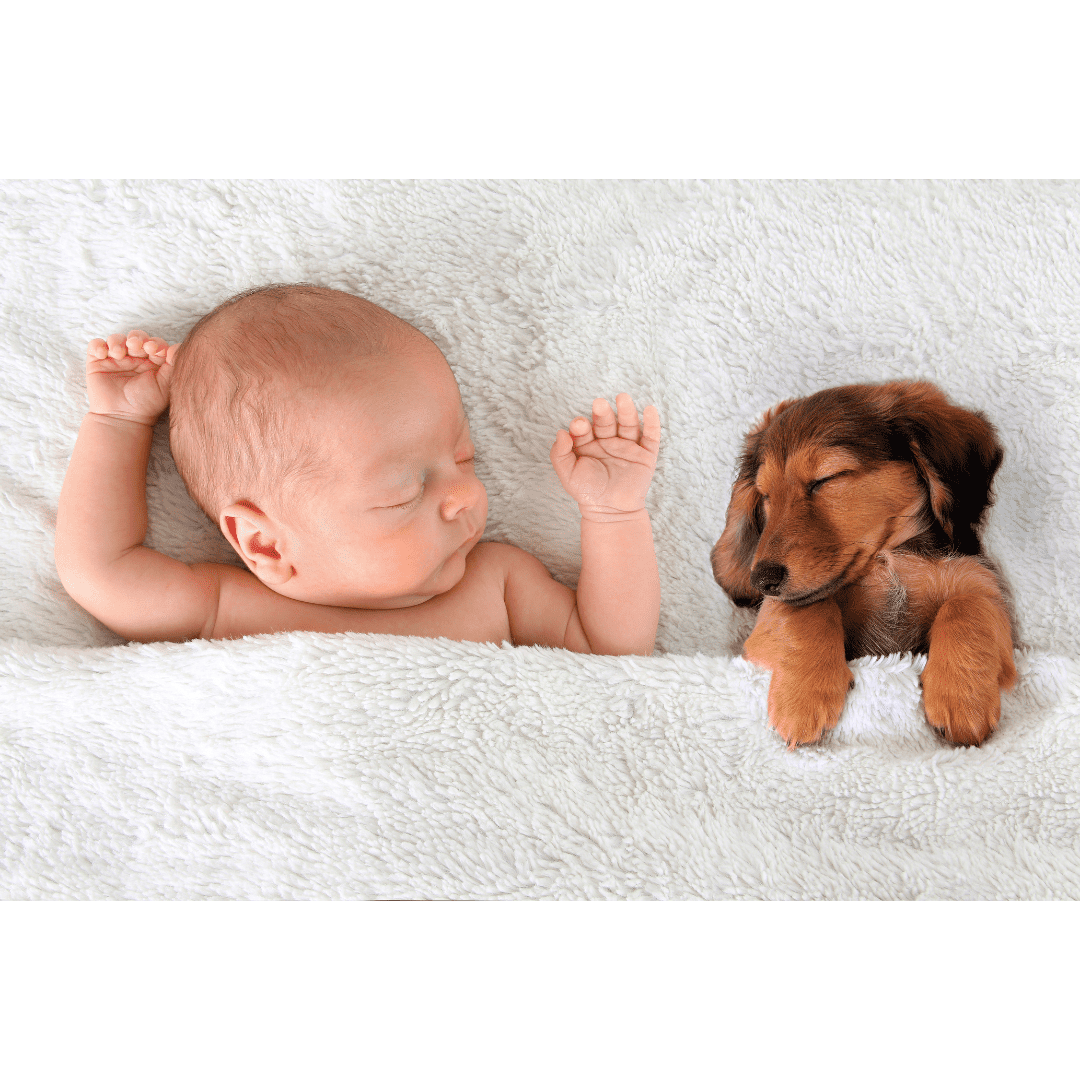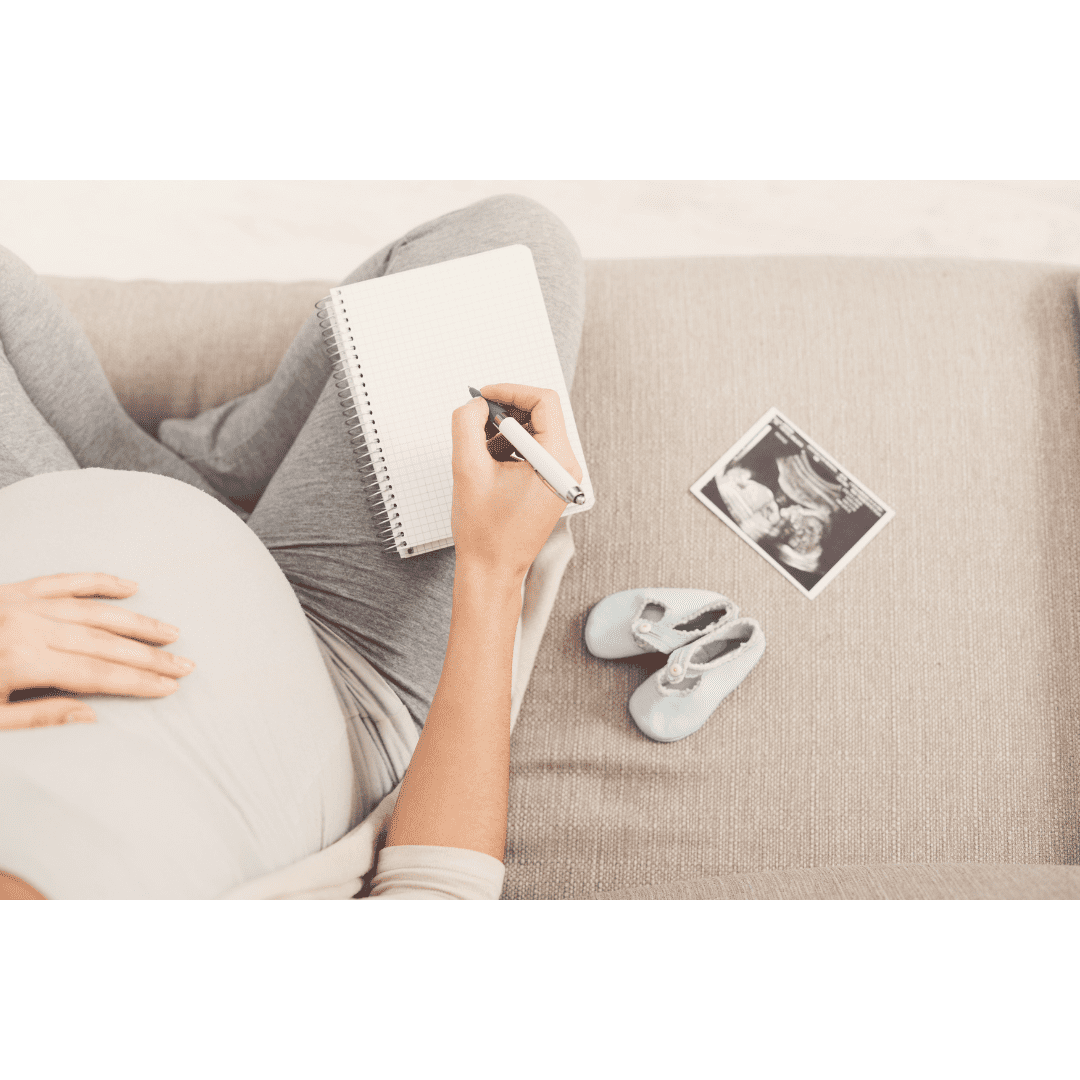Dogs And Babies: How To Prepare Your Pet For The Arrival Of Your Newborn

Dogs and Babies:
How To Prepare Your Pet For The Arrival Of Your Newborn
If there’s one thing we’ve noticed during all the virtual classes we’ve taught since the Pandemic began, it’s how many of you have DOGS at home! Your furry companions are snuggled up next to you in every class, making cameo appearances to let us know they’re a part of the family, too.
It makes sense, then, to consider your pup as you prepare for the birth of your baby. What practices can families implement ahead of time to help make this transition as smooth as possible for their fur-children?
We reached out to award-winning dog behavioral expert, Lesley Shade, of At Attention Dog Training located in King of Prussia, PA. Lesley was happy to chat with us and answer a bunch of your most pressing questions:
“I’m pregnant and we’ve recently adopted a puppy. What’s the best way to prepare my “fur baby” ahead of time?”
AADT: Having a new puppy before growing your family presents a unique opportunity! Puppies go through developmental stages during puppyhood that influence their behavior for the rest of their lives. In particular, the “Critical Period of Socialization” generally occurs during the first 16 weeks of life. During this developmental stage, puppies are very sensitive to the world around them. The interactions and experiences they have (positive or negative) will have long-lasting effects on their behaviors and ability to adapt. The good news is that you have an amazing opportunity to influence those interactions for the better!
At Attention Dog Training® refers to this influential process as Crafting Positive Experiences© (CPE). You can prepare your own puppy for your baby by orchestrating planned meetings with a friend’s infant or toddler and offering your pup high value food rewards during those interactions to provide a positive association for your puppy. The experience should be short and sweet and your puppy’s body language should be loose and relaxed. Reading your dog’s body language takes time to interpret, but it’s so important that dog owners learn the subtle signs that a dog exhibits when uncomfortable or stressed.
If having your puppy meet babies/children isn’t an option, use YouTube videos of infants crying or children talking/playing set initially on low volume while your puppy enjoys a yummy food enrichment toy like a Toppl ® or KONG ® stuffed with soft food rewards. Once the food is gone, stop playing the sounds.
“My husband and I are expecting a baby, but our older dog is used to being an “only child”. How can we make it easier on him when we bring the new baby home?”
AADT: Ideally, training your dog starts before the baby comes home. New habits such as polite manners as well as more lengthy behavior modification changes can take time for a dog to learn. A baby often disrupts the routine of everyone in the house, including your dog. Added stress can make learning more difficult, just like with humans! Behaviors that haven’t been a priority before easily become magnified when a new baby is present. Poor leash manners, dog reactivity, overall manners, and more can be much harder to deal with when everyone is just trying to survive life with a newborn.
It is important to offer dogs an opportunity to practice situations they may experience when a new baby comes home. For example, walking next to a stroller may be new and scary – it changes the position of their normal walking spot, can be loud, and unpredictable in movement. Start acclimating your dog to the stroller when it’s locked/stationary inside your home while simultaneously giving your dog high value treats. Once your dog is comfortable, move to the next step – making the stroller roll back and forth and giving your dog those treats. Baby steps are key for our dogs!
We also encourage families to consider their sleeping arrangements. While we know our pups make excellent snuggle mates, when a new baby arrives, families may prefer to have their dog elsewhere due to late-night feedings or because the baby’s bassinet is in the bedroom. Any sudden changes in a dog’s routine can cause stress and stress can lead to behavioral issues! Plan ahead and help your dog love new sleeping arrangements that don’t interfere with a newborn’s schedule.
“My dog is acting out now that we’ve brought our newborn home. What do you suggest we do to help her? It seems like she is anxious all the time.”
AADT: There is an old adage shared on social media that suggests dogs will “know your baby is part of their pack” and will be, “just fine” when you bring your baby home. This narrative is dangerous, false, and creates unrealistic expectations for both dogs and owners. Many dogs struggle with the new noises infants make and get stressed at disruptions to their own routines. This can all escalate even further once the baby learns how to crawl/walk, because now the noises have teamed up with wildly unpredictable movements and actions. Management solutions will play a large part in your everyday life as you work to keep your baby safe and your dog comfortable!
First, you should immediately offer your dog space away from your child to rest. The successful resolution of undesirable behaviors is to get to the root cause of the fear/anxiety/stress and work on changing your dog’s emotional response to potential triggers. If your dog is experiencing increased stress and anxiety, adding fear won’t help them feel better. The use of bark collars, e-stim, spray or shock collars, spray bottles, hitting, kicking, prong collars, choke chains etc. will not make your dog feel better about your new addition, but instead can contribute to making your dog act aggressively towards your baby.
Consider reaching out to a Certified Professional Dog Trainer committed to modern, humane and ethical methods. These trainers will never resort to adding pain, fear or intimidation in an effort to suppress undesirable behaviors. They will be able to make immediate recommendations and help you implement an appropriate training program. Depending on your dog’s anxiety levels, it may be necessary to work in tandem with a Veterinary Behaviorist as part of the training plan. Working with the right skilled team of professionals can remove added stress for new families; don’t delay!
“Help! My baby is mobile! Any suggestions on how to baby-proof to ensure that my pet is comfortable too, since parts of our home are now gated off?”
AATD: As infants grow, the strategies for helping dogs be successful must also change. Jennifer Shyrock, CDBC, owner of Family Paws™ LLC has outlined the different milestones that infants go through and offers suggested strategies to help dogs so that everyone can live together happily! From the newborn phase, rolling over, grasping, sitting, to crawling and beyond – adjusting the strategies we employ to keep dogs and children safe is key.
The use of management tools such as crates, gates, playpens, and tethering aim to increase safety and reduce incidents from happening as both children and dogs require supervision to ensure everyone is comfortable. In her “5 Types of Supervision”, Jennifer outlines the following levels of supervision: Absent, Passive, Reactive, Proactive and Active. Proactive and Active supervision of both children and dogs should be prioritized daily. Some dogs may require training to help them feel comfortable with being behind a gate or separated from their family within the home and it’s important to take time to help them cope with this change.

Source: https://www.familypaws.com/services/for-parents-and-families/
“Both my dog and my baby want to be with me 24/7. Separating the dog stresses her out. Being together means my baby has access to the dog’s toys and bed (we keep food and water in a separate location) and tries to crawl all over her. I’m feeling overwhelmed.”
AADT: Meeting the needs of everyone and taking care of your own needs can be quite the balancing act! Offering daily walks and mental enrichment games can increase the likelihood that your dog will feel more relaxed throughout the day. Enrichment offers dogs a way to exercise their mind and engage their natural seeker system in a fun manner. This can be as simple as using a puzzle bowl or snuffle mat as a feeder for their daily meal(s).
New families often benefit from hiring an excellent dog walker to help ensure their dog gets the physical exercise they need and chances to sniff outside. Using proper management strategies to keep interested toddlers away from a dog’s feeding station and toys is paramount so that dogs never feel their resources are threatened – great job in separating those!
Remember – it’s important to realize the cognition levels of both your baby and your dog. A baby doesn’t understand what appropriate interaction is and neither does your dog! It’s our role as parents to set up successful management techniques to keep everyone safe.
At Attention Dog Training offers a variety of award-winning classes and programs that are based on decades of scientific research and delivered through the use of positive reinforcement. These include Baby Prep sessions, Puppy BootCamp, and private one-on-one training at their facility or your home. Expecting families receive additional support, such as recommendations for sleeping arrangements and additional protocols to practice before the baby arrives. All dogs are welcome no matter their breed, age or behavior. To learn more, visit www.atattentiondogs.com or call 484-393-2288.


 Ivory Tree Studios 2019-2021
Ivory Tree Studios 2019-2021